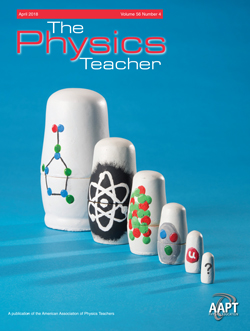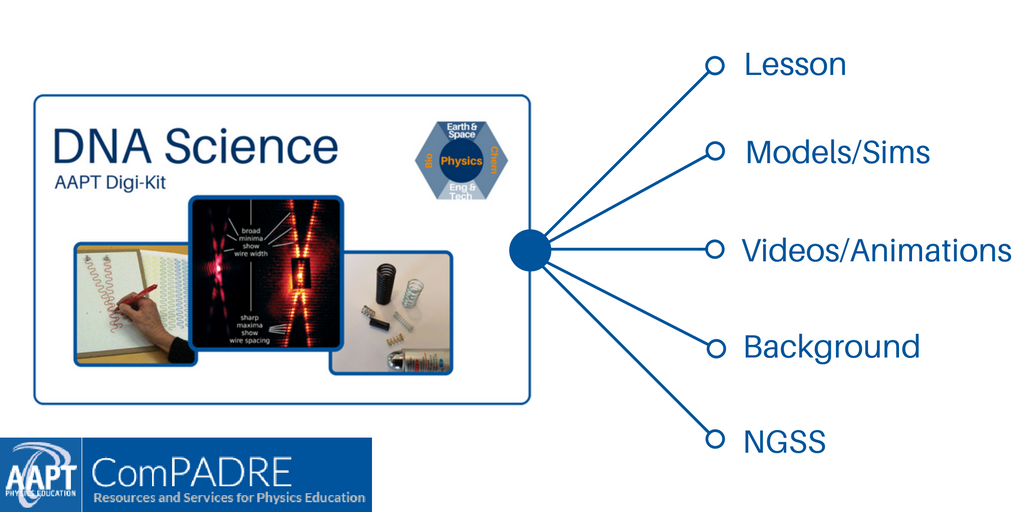Volume 56 Issue 4, April 2018
The Physics Teacher
This month's cover suggests a Russian doll metaphor for the canonical particle hierarchy—inside molecules are atoms, which house nuclei, which consist of protons and neutrons, which are composed of quarks and gluons ... but what lurks within? For some clues, see “And So Ad Infinitum: The Search for Quark and Lepton Substructure” by Don Lincoln. (cover art by Reidar Hahn, Fermilab)
Letters to the Editor
Teaching the Bohr atom by Ken Ford. DOI: 10.1119/1.5028224
Recombining rainbows by Kirk McDonald. DOI: 10.1119/1.5028225
More about moiré by Carlos H. Wörner. DOI: 10.1119/1.5028226
Erratum: to February “Figuring Physics” answer. DOI: 10.1119/1.5028227
AAPT Awards
Homer L. Dodge Citations for Distinguished Service to AAPT. DOI: 10.1119/1.5025283
Columns
And the Survey Says..., Figuring Physics, iPhysicsLabs, Astronotes, Physics Challenge for Teachers and Students, Fermi Questions, Talkin' Physics, Technology in the Classroom, Talkin' Physics, Little Gems, Visual Physics, and Websights.
Papers
Projectile Motion Hoop Challenge by Connor Jordan, Amy Dunn, Zachary Armstrong, and Wendy K. Adams. DOI: 10.1119/1.5028229
And So Ad Infinitum: The Search for Quark and Lepton Substructure by Don Lincoln. DOI: 10.1119/1.5028231
Using Elementary Mechanics to Estimate the Maximum Range of ICBMs by Joseph Amato. DOI: 10.1119/1.5028232
In Praise of the Catenary by F. Behroozi. DOI: 10.1119/1.5028233
Clash of Harmonics in Stravinsky’s The Rite of Spring by Michael J. Ruiz. DOI: 10.1119/1.5028234
Two Balls’ Collision of Mass Ratio 3:1 by Yasuo Ogawara, and Michael M. Hull. DOI: 10.1119/1.5028235
A Pictorial Approach to Lenz’s Law by Andrew Duffy. DOI: 10.1119/1.5028236
A Classroom Activity for Teaching Electric Polarization of Insulators and Conductors by Christos Deligkaris. DOI: 10.1119/1.5028237
The Graphics Tablet – A Valuable Tool for the Digital STEM Teacher by Jeff Stephens. DOI: 10.1119/1.5028238
Accessing High Spatial Resolution in Astronomy Using Interference Methods by Cyril Carbonel, Sébastien Grasset, and Jean Maysonnave. DOI: /10.1119/1.5028239
Flawed Applications of Bernoulli’s Principle by Panagiotis Koumaras, and Georgios Primerakis. DOI: 10.1119/1.5028240
Campus as a Living Laboratory for Sustainability: The Physics Connection by Timothy Lindstrom, and Catherine Middlecamp. DOI: 10.1119/1.5028242
Interesting Guided-Inquiry Labs for a Large-Enrollment, Active Learning Physics II Course by Kasey Wagoner, K. Mairin Hynes, and Daniel Flanagan. DOI: /10.1119/1.5028243
Fluids Demonstrations: Trailing Vortices, Plateau Border, Angle of Repose, and Flow Instability by Said Shakerin. DOI: 10.1119/1.5028244
Thorium and Molten Salt Reactors: Essential Questions for Classroom Discussions by Gregory A. DiLisi, Allison Hirsch, Meredith Murray, and Richard Rarick. DOI: 10.1119/1.5028245
Additional Resources
Race and Physics Teaching Collection Resource
DNA Science Lesson & Digi-Kit
Inspired by an article from The Physics Teacher, this multidisciplinary lesson and digital resource collection is based on How Rosalind Franklin Discovered the Helical Structure of DNA: Experiments in Diffraction (Braun, Tierney, & Schmitzer, 2011). Click the image to access this resource.



